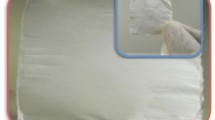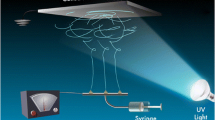Abstract
Oxime grafted polyacrylonitrile (OX-g-PAN) nanofibers (NFs) membrane was prepared by combining electrospinning and chemical grafting techniques. The membrane was extensively characterized with field emission scanning electron microscopy (FE-SEM) and Fourier transforms infrared (FT-IR) spectroscopy. High percent grafting (79 %) with no change in the physical nature was confirmed by FT-IR spectra. The adsorption kinetics of methylene blue (MB), rhodamine B (RB) and safranin T (ST) onto OX-g-PAN NFs membranes followed a pseudo-second-order model and no change in the intraparticle diffusion pattern was observed. The order of adsorption capacity ((qmax) at equilibrium time) was; MB (102.15 mg/g) < ST (118.34 mg/g) < RB (221.24 mg/g). The adsorption data for the dyes fitted well to Langmuir (r 2 values and varied from 0.950 to 0.985 and Freundlich (r 2 values varied from 0.988 to 0.996) equations. The increased adsorption by OX-g-PAN NFs membrane could be attributed to the increased exposed surface and number of active sites on the membranes. The good fitting to adsorption equations showed that beside condensation (physical adsorption) monolayer adsorption has also occurred. The adsorption capacity values of the present system were higher as compared to the values reported in the literature for conventional adsorbents.









Similar content being viewed by others
References
Kannan N, Meenakshisundaram M (2001) Adsorption of congo red on activated carbons: A comparative study. Water, Air and Soil Poll 138:289–305
Lee JW, Choi SP, Thiruvenkatachari RR, Shim WG, Moon H (2006) Submerged microfiltration membrane coupled with alum coagulation/powdered activated carbon adsorption for complete decolorization of reactive dyes. Water Res 40:435–444
Majewska-Nowak K (1989) Effect of flow conditions on ultrafiltration efficiency of dye solutions and textile effluents. Desalination 71:127–135
Salem IA, El-maazawi M (2000) Kinetics and mechanism of color removal of methylene blue with hydrogen peroxide catalyzed by some supported alumina surfaces. Chemosphere 41:1173–1180
Song S, Fan J, He Z, Zhan L, Lin Z, Chen J, Xu X (2010) Electrochemical degradation of azo dye C.I. reactive red 195 by anodic oxidation on Ti/SnO2-Sb/PbO2electrodes. Electrochim Acta 55:3606–3613
Xia F, Ou E, Wang XE, Wang J (2008) Photocatalytic degradation of dyes over cobalt doped mesoporous SBA-15 under sunlight. Dyes Pigm 76:76–81
Suna D, Zhang X, Wu Y, Liu X (2010) Adsorption of anionic dyes from aqueous solution on fly ash. J Hazard Mater 181:335–342
Liu J, Curry JA, Rossow WB, Key JR, Wang X (2005) Comparison of surface radiative flux data sets over the Arctic Ocean. J Geophys Res 110:C2015
Mall ID, Srivastava VC, Agarwal NK (2006) Removal of orange-G and methyl violet dyes by adsorption onto bagasse fly ash-kinetic study and equilibrium isotherm analyses. Dyes Pigm 69:210–223
Barka N, Assabbane A, Nounah A, Laanab L, Ichou YA (2009) Removal of textile dyes from aqueous solutions by natural phosphate as a new adsorbent. Desalination 235:264–275
Benguella B, Yacouta-Nour A (2009) Adsorption of bezanyl red and nylomine green from aqueous solutions by natural and acid-activated bentonite. Desalination 235:276–292
Gomez V, Larrechi MS, Callao MP (2007) Kinetic and adsorption study of acid dye removal using activated carbon. Chemosphere 69:1151–1158
Cestari AR, Vierira EFS, Tavares AMG, Bruns RE (2008) The removal of the indigo carmine dye from aqueous solutions using cross-linked chitosan-evaluation of adsorption thermodynamics using a full factorial design. J Hazard Mater 153:566–574
Crini G (2008) Kinetic and equilibrium studies on the removal of cationic dyes from aqueous solution by adsorption onto a cyclodextrin polymer. Dyes Pigm 77:415–426
Dhodapkar R, Rao NN, Pande SP, Kaul SN (2006) Removal of basic dyes from aqueous medium using a novel polymer: Jalshakti. Bioresour Technol 97:877–885
Saeed K, Haider S, Oh TJ, Park SY (2008) Preparation of amidoxime-modified polyacrylonitrile (PAN-oxime) nanofibers and their applications to metal ions adsorption. J Membr Sci 322:400–405
Thavasi V, Singh G, Ramakrishna S (2008) Electrospun nanofibers in energy and environmental applications. Energy Environ Sci 1:205–221
Bhardwaj N, Kundu SC (2010) Electrospinning a fascinating fiber fabrication technique. Biotechnol Advan 28:325–347
Morton WJ (1902) Method of Dispersing Fluids. US Patent 705:691
Doshi J, Reneker DH (1995) Electrospinning process and application of electrospun fibers. J Electrostat 35:151–160
Gupta P, Asmatulu R, Claus R, Wilkes G (2006) Superparamagnetic flexible substrates based on submicron electrospun estane fibers containing MnZnFe-Ni nanoparticles. JAppl Poly Sci 100:4935–4942
Nataraja K, Yangb KS, Aminabhavi TM (2012) Polyacrylonitrile-based nanofibers-A state-of-the-art review. Prog Polym Sci 37:487–513
Ramakrishna S, Fujihara K, Teo WE, Lim TC, Ma Z (2005) An introduction to electrospinning and nanofibers. World Sci. Publish. Co Pte Ltd, Singapore
Deitzel JM, Kleinmeyer J, Harris D, Tan NCB (2001) The effect of processing variables on the morphology of electrospun nanofibers and textiles. Polymer 42:261–272
Haider S, Al-Zeghayer Y, Al-Masry WA, Ali FA (2012) Fabrication of chitosan nanofibers membrane with improved stability and britility. Adv Sci Lett 17:217–223
Haider S, Al-Masry WA, Bukhari N, Javid M (2010) Preparation of the chitosan containing nanofibers by electrospinning chitosan-gelatin complexes. Polym Eng Sci 50:1887–1893
Kriegel C, Kit KM, McClements DJ, Weiss J (2009) Electrospinning of chitosan-poly (ethylene oxide) blend nanofibers in the presence of micellar surfactant solutions. Polymer 50:189–200
Bilba N, Bilba D, Moroi G (2004) Synthesis of a polyacrylamidoxime chelating fiber and its efficiency in the retention of palladium ions. J Appl Polym Sci 92:3730–3735
Alakhras FA, Dari KA, Mubarak MS (2005) Synthesis and chelating properties of some poly(amidoxime-hydroxamic acid) resins toward some trivalent lanthanide metal ions. J Appl Polym Sci 97:691–697
Weber WJ, Morris JC (1963) Kinetics of adsorption on carbon from solution. J Sanit Eng Div Am Soc Civ Eng 89:31–39
Chen JP, Wu S, Chong KH (2003) Surface modification of a granular activated carbon by citric acid for enhancement of copper adsorption. Carbon 41:1979–1986
Mall ID, Srivastava VC, Agarwal NK, Mishra IM (2005) Removal of congo red from aqueous solution by bagasse fly ash and activated carbon: kinetic study and equilibrium isotherm analyses. Chemosphere 61:492–501
Vinayagam V, Thangaraju P (2012) Equilibrium and kinetics of adsorption of cationic dyes by STISHOVITE Clay-TiO2 Nanocomposite. Int J Modern Eng Res 2:3989–3995
Kairvelu K, Namasivayam C (2000) Agricutural by-product as metal adsorbent: Sorption of Lead(II) from aqueous solution onto coirpith carbon. Environm Techn 21:1091–1097
Gong R, Li M, Yang C, Sun Y, Chen J (2005) Removal of cationic dyes from aqueous solution by adsorption on peanut hull. J Hazard Mater 121:247–250
Annadurai G, Juang RS, Lee DJ (2002) Use of cellulose-based wastes for adsorption of dyes from aqueous solutions. J Hazard Mater 92:263–274
Vadivelan V, Kumar KV (2005) Equilibrium, kinetics, mechanism, and process design for the sorption of methylene blue onto rice husk. J Colloid Interface Sci 286:90–100
Tsai WT, Yang JM, Lai CW, Cheng YH, Lin CC, Yeh CW (2006) Characterization and adsorption properties of eggshells and eggshell membrane. Bioresour Technol 97:488–493
Aygun A, Yenisoy-Karakas S, Duman I (2003) Production of granular activated carbon from fruit stones and nutshells and evaluation of their physical, chemical and adsorption properties. Microporous Mesoporous Mater 66:189–195
Parimaladevi P, Venkateswaran V (2011) Adsorption of cationic dyes (rhodamine B and methylene blue) from aqueous solution using treated fruit waste. J Appl Tech in Environm Sanitation 1:285–293
Selvam PP, Preethi S, Basakaralingam P, Thinakaran N, Sivasamy A, Sivanesan S (2008) Removal of rhodamine B from aqueous solution by adsorption onto sodium montmorillonite. J Hazard Mater 155:39–44
Wang S, Soudi M, Li L (2006) Coal ash conversion into effective adsorbents for removal of heavy metals and dyes from wastewater. J Hazard Mater B 133:243–251
Wang Y, Mu Y, Zhao QB (2006) Isotherm, kinetics and thermodynamics of dyes biosorption by anaerobic sludge. Sep Purif Technol 50:1–7
Wang S, Li H (2005) Dye adsorption on unburned carbon: Kinetic and equilibrium. J Hazard Mater 126:71–77
Wang S, Zhu ZH (2006) Characterization and environmental application of an Australian natural zeolite for basic dye removal from aqueous solution. J Hazard Mater 136:946–952
Khan TA, Dahiya S, Ali I (2012) Use of kaolonite as adsorbent: Equilibrium, dynamics and thermodynamic studies on the adsorption of rhodamine B from aqueous solution. Appl Clay Sci 69:58–66
Umoren SA, Etim UJ, Israel AU (2013) Adsorption of methylene blue from industrial effluent using poly (vinyl alcohol). J Mater Environ Sci 4:75–86
Shahryari Z, Goharrizi AS, Azadi M (2010) Experimental study of methylene blue adsorption from aqueous solutions onto carbon nano tubes. Int J Water Res Environ Eng 2:16–28
Chowdhury S, Mishra R, Kushwaha P, Saha P (2012) Removal of safranin from aqueous solutions by NaOH-treated rice husk: thermodynamics, kinetics and isosteric heat of adsorption. Asia-Pac J Chem Eng 7:236–249
Safark I, Nymburska K, Safarkova M (1997) Adsorption of water soluble organic dyes on magnetic charcoal. J Chem Tech Biotechnol 69:1–4
Safarikova M, Ptackova L, Kibrikova I, Safarik I (2005) Biosorption of water-soluble dyes on magnetically modified brewer’s yeast. Chemosphere 59:831–835
Acar I, Bal A, Guclu G (2012) Adsorption of basic dyes from aqueous solutions by depolymerization products of post-consumer PET bottles. Clean–Soil Air, Water 40:325–333
Guclu G, Keles S (2007) Removal of basic dyes from aqueous solutions using starch-graft-acrylic acid copolymers. J Appl Polym Sci 106:2422–2426
Spitzer DP (1988) Effective surface areas of coals measured by dye adsorption. Prepr Pap Am Chem Soc, Div Fuel Chem 33:789–796
Lee S, Obendorf SK (2007) Use of electrospun nanofiber web for protective textile materials as barriers to liquid penetration. Textile Res J 77:696–702
Haider S, Bukhari N, Park SY, Iqbal Y, Al-Masry WA (2011) Adsorption of bromo-phenol blue from an aqueous solution onto thermally modified granular charcoal, chemical engineering research and design. Chem Eng Res and Des 89:23–28
Acknowledgement
Financial support from the National Plan for Science and Technology, King Saud University, Saudi Arabia under the project number 10NAN1017-2 is greatly acknowledged.
Author information
Authors and Affiliations
Corresponding author
Rights and permissions
About this article
Cite this article
Haider, S., Binagag, F.F., Haider, A. et al. Electrospun oxime-grafted-polyacrylonitrile nanofiber membrane and its application to the adsorption of dyes. J Polym Res 21, 371 (2014). https://doi.org/10.1007/s10965-014-0371-1
Received:
Accepted:
Published:
DOI: https://doi.org/10.1007/s10965-014-0371-1




